长时回调#
大多数 Web 服务器默认有 30 秒的超时时间,这对于需要更长时间才能完成的回调是一个问题。虽然你可以在 Web 服务器上增加超时时间,但你可能会允许长时间运行的回调使用应用程序的所有工作人员,从而阻止其他请求通过。长回调为使用长时间运行的回调提供了一个可扩展的解决方案。
长回调可以通过装饰器 @app.long_callback 添加到你的应用程序中。带有此装饰器的回调使用由您配置的后端来运行回调逻辑。目前有两种选择:
DiskCache 后端,在单独的进程中运行回调逻辑,并使用
diskcache库将结果存储到磁盘。这是本地开发最容易使用的后端,但不推荐用于生产。一个 Celery 后端,在 Celery 工作器中运行回调逻辑,并通过 Celery 代理(如 RabbitMQ 或 Redis)将结果返回给 Dash 应用。与 Disk Cache 不同,它使用一个作业队列,并且不会意外地消耗所有服务器资源,因此建议在生产环境中使用此方法。
下面的示例使用 diskcache 管理器,它需要 diskcache、multiprocess 和 psutil 库:
$ pip install diskcache multiprocess psutil
使用长回调的第一步是使用选择的后端配置长回调管理器实例。
@app.long_callback 装饰器需要这个长回调管理器实例。您可以为 Dash 提供管理者实例。Dash 应用构造函数作为 long_callback_manager 关键字参数,或者作为 manager 参数 @app.long_callback 装饰本身。
在下面的五个示例中,我们将详细讨论如何实现长回调。
简单例子#
下面是一个使用 @app.long_callback 的简单示例。注册一个更新 html.P 的回调函数表示按钮被单击的次数。回调使用 time.sleep 来模拟长时间运行的操作。
import time
import dash
from dash import html
from dash.long_callback import DiskcacheLongCallbackManager
from dash.dependencies import Input, Output
## Diskcache
import diskcache
cache = diskcache.Cache("./cache")
long_callback_manager = DiskcacheLongCallbackManager(cache)
app = dash.Dash(__name__)
app.layout = html.Div(
[
html.Div([html.P(id="paragraph_id", children=["Button not clicked"])]),
html.Button(id="button_id", children="Run Job!"),
]
)
@app.long_callback(
output=Output("paragraph_id", "children"),
inputs=Input("button_id", "n_clicks"),
manager=long_callback_manager,
)
def callback(n_clicks):
time.sleep(2.0)
return [f"Clicked {n_clicks} times"]
if __name__ == "__main__":
app.run_server(debug=True)
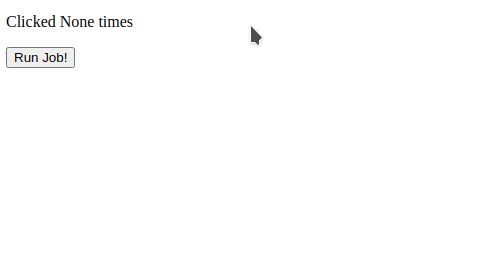
在回调运行时禁用按钮#
注意,在前面的示例中,没有显示长回调正在运行。用户可能会在原始作业完成之前多次单击“Run Job!”按钮。我们可以通过在回调运行时禁用按钮,并在回调完成时重新启用它来解决这些缺点。
这是使用 @app.long_callback 的 running 参数完成的。这个参数接受一个由 3 个元素组成的元组列表。每个元组的第一个元素必须是一个 Output 依赖对象,该对象引用了应用布局中组件的属性。第二个元素是在回调运行时属性应该设置的值,第三个元素是回调完成时属性应该设置的值。
本例使用 running 来在回调运行时将按钮的 disabled 属性设置为 True,在回调完成时设置为 False。
在本例中,长回调管理器提供给 Dash。Dash 应用构造函数而不是 @app.long_callback 装饰。
import time
import dash
from dash import html
from dash.long_callback import DiskcacheLongCallbackManager
from dash.dependencies import Input, Output
## Diskcache
import diskcache
cache = diskcache.Cache("./cache")
long_callback_manager = DiskcacheLongCallbackManager(cache)
app = dash.Dash(__name__, long_callback_manager=long_callback_manager)
app.layout = html.Div(
[
html.Div([html.P(id="paragraph_id", children=["Button not clicked"])]),
html.Button(id="button_id", children="Run Job!"),
]
)
@app.long_callback(
output=Output("paragraph_id", "children"),
inputs=Input("button_id", "n_clicks"),
running=[
(Output("button_id", "disabled"), True, False),
],
)
def callback(n_clicks):
time.sleep(2.0)
return [f"Clicked {n_clicks} times"]
if __name__ == "__main__":
app.run_server(debug=True)
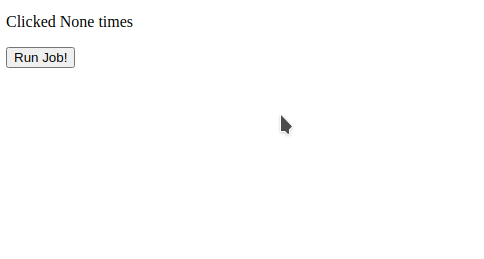
可取消回调#
这个示例建立在前一个示例的基础上,添加了对 @app.long_callback 使用 cancel 参数取消长时间运行的回调的支持。我们将 cancel 参数设置为一个 Input 依赖对象列表,这些对象引用应用布局中某个组件的属性。当此属性的值在回调运行时发生更改时,回调将被取消。注意,属性的值并不重要——值的任何更改都会取消正在运行的作业(如果有的话)。
import time
import dash
from dash import html
from dash.long_callback import DiskcacheLongCallbackManager
from dash.dependencies import Input, Output
## Diskcache
import diskcache
cache = diskcache.Cache("./cache")
long_callback_manager = DiskcacheLongCallbackManager(cache)
app = dash.Dash(__name__, long_callback_manager=long_callback_manager)
app.layout = html.Div(
[
html.Div([html.P(id="paragraph_id", children=["Button not clicked"])]),
html.Button(id="button_id", children="Run Job!"),
html.Button(id="cancel_button_id", children="Cancel Running Job!"),
]
)
@app.long_callback(
output=Output("paragraph_id", "children"),
inputs=Input("button_id", "n_clicks"),
running=[
(Output("button_id", "disabled"), True, False),
(Output("cancel_button_id", "disabled"), False, True),
],
cancel=[Input("cancel_button_id", "n_clicks")],
)
def callback(n_clicks):
time.sleep(2.0)
return [f"Clicked {n_clicks} times"]
if __name__ == "__main__":
app.run_server(debug=True)
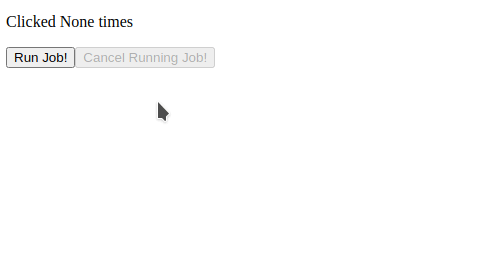
进度条#
这个例子使用了 @app.long_callback 的 progress 参数,在回调运行时更新进度条。我们将 progress 参数设置为 Output 依赖分组,该分组引用应用布局中组件的属性。
当一个依赖分组被分配给 @app.long_callback 的 progress 参数时,使用一个新的特殊参数作为函数的第一个参数。这个特殊的参数在下面的例子中被命名为 set_progress,它是一个函数句柄,修饰函数调用它是为了更新应用程序的当前进度。set_progress 函数接受单个参数,该参数对应于传递给 @app.long_callback 的 progress 参数的 Output 依赖项分组中指定的属性分组。
import time
import dash
from dash import html
from dash.long_callback import DiskcacheLongCallbackManager
from dash.dependencies import Input, Output
## Diskcache
import diskcache
cache = diskcache.Cache("./cache")
long_callback_manager = DiskcacheLongCallbackManager(cache)
app = dash.Dash(__name__, long_callback_manager=long_callback_manager)
app.layout = html.Div(
[
html.Div(
[
html.P(id="paragraph_id", children=["Button not clicked"]),
html.Progress(id="progress_bar"),
]
),
html.Button(id="button_id", children="Run Job!"),
html.Button(id="cancel_button_id", children="Cancel Running Job!"),
]
)
@app.long_callback(
output=Output("paragraph_id", "children"),
inputs=Input("button_id", "n_clicks"),
running=[
(Output("button_id", "disabled"), True, False),
(Output("cancel_button_id", "disabled"), False, True),
(
Output("paragraph_id", "style"),
{"visibility": "hidden"},
{"visibility": "visible"},
),
(
Output("progress_bar", "style"),
{"visibility": "visible"},
{"visibility": "hidden"},
),
],
cancel=[Input("cancel_button_id", "n_clicks")],
progress=[Output("progress_bar", "value"), Output("progress_bar", "max")],
)
def callback(set_progress, n_clicks):
total = 10
for i in range(total):
time.sleep(0.5)
set_progress((str(i + 1), str(total)))
return [f"Clicked {n_clicks} times"]
if __name__ == "__main__":
app.run_server(debug=True,port=8054)
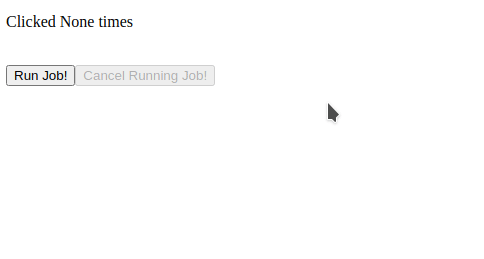
进度条形图#
@app.long_callback 的 progress 参数可以用来更新任意组件属性。这个例子创建并更新了一个 Plotly 条形图来显示当前的计算状态。
这个例子还使用了 long_callback 的 progress_default 参数来指定一组值,当回调没有进行时,这些值应该被分配给由 progress 参数指定的组件。如果没有提供 progress_default,则在回调未运行时,progress 中指定的所有依赖项属性都将设置为 None。在本例中,progress_default 被设置为一个宽度为零的图形。
import time
import dash
import dash_html_components as html
from dash import html, dcc
from dash.long_callback import DiskcacheLongCallbackManager
from dash.dependencies import Input, Output
import plotly.graph_objects as go
## Diskcache
import diskcache
cache = diskcache.Cache("./cache")
long_callback_manager = DiskcacheLongCallbackManager(cache)
def make_progress_graph(progress, total):
progress_graph = (
go.Figure(data=[go.Bar(x=[progress])])
.update_xaxes(range=[0, total])
.update_yaxes(
showticklabels=False,
)
.update_layout(height=100, margin=dict(t=20, b=40))
)
return progress_graph
app = dash.Dash(__name__, long_callback_manager=long_callback_manager)
app.layout = html.Div(
[
html.Div(
[
html.P(id="paragraph_id", children=["Button not clicked"]),
dcc.Graph(id="progress_bar_graph", figure=make_progress_graph(0, 10)),
]
),
html.Button(id="button_id", children="Run Job!"),
html.Button(id="cancel_button_id", children="Cancel Running Job!"),
]
)
@app.long_callback(
output=Output("paragraph_id", "children"),
inputs=Input("button_id", "n_clicks"),
running=[
(Output("button_id", "disabled"), True, False),
(Output("cancel_button_id", "disabled"), False, True),
(
Output("paragraph_id", "style"),
{"visibility": "hidden"},
{"visibility": "visible"},
),
(
Output("progress_bar_graph", "style"),
{"visibility": "visible"},
{"visibility": "hidden"},
),
],
cancel=[Input("cancel_button_id", "n_clicks")],
progress=Output("progress_bar_graph", "figure"),
progress_default=make_progress_graph(0, 10),
interval=1000,
)
def callback(set_progress, n_clicks):
total = 10
for i in range(total):
time.sleep(0.5)
set_progress(make_progress_graph(i, 10))
return [f"Clicked {n_clicks} times"]
if __name__ == "__main__":
app.run_server(debug=True)
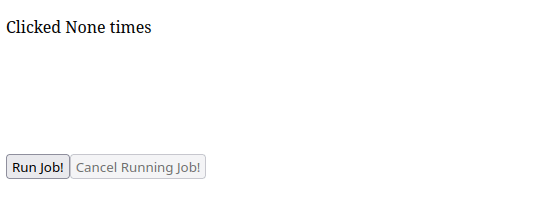
Celery/Redis#
我们建议在生产环境中使用 Celery/Redis 后端。
使用 Celery 和Redis,示例看起来像这样:
import time
import dash
from dash import html
from dash.long_callback import CeleryLongCallbackManager
from dash.dependencies import Input, Output
from celery import Celery
celery_app = Celery(
__name__, broker="redis://localhost:6379/0", backend="redis://localhost:6379/1"
)
long_callback_manager = CeleryLongCallbackManager(celery_app)
app = dash.Dash(__name__, long_callback_manager=long_callback_manager)
app.layout = html.Div(
[
html.Div([html.P(id="paragraph_id", children=["Button not clicked"])]),
html.Button(id="button_id", children="Run Job!"),
html.Button(id="cancel_button_id", children="Cancel Running Job!"),
]
)
@app.long_callback(
output=Output("paragraph_id", "children"),
inputs=Input("button_id", "n_clicks"),
running=[
(Output("button_id", "disabled"), True, False),
(Output("cancel_button_id", "disabled"), False, True),
],
cancel=[Input("cancel_button_id", "n_clicks")],
)
def callback(n_clicks):
time.sleep(2.0)
return [f"Clicked {n_clicks} times"]
if __name__ == "__main__":
app.run_server(debug=True)
在 DiskcacheLongCallbackManager 的位置,我们使用 CeleryLongCallbackManager 并使用如下行导入Celery:from celery import Celery。
我们配置一个 Celery 应用程序(celery_app),并将其传递给 CeleryLongCallbackManager。它被存储在变量 long_callback_manager 中,然后传递给应用程序:
app = dash.Dash(__name__, long_callback_manager=long_callback_manager)
缓存结果#
@app.long_callback 装饰器可以选择通过缓存来记忆回调函数的结果,并且它提供了一个灵活的 API 来配置缓存的结果何时可以被重用。
